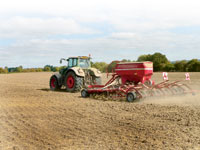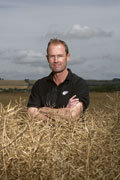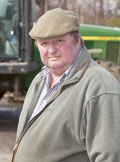Seeds Focus: Barometer farmers look to mix new varieties with old

Tried and tested varieties will dominate our Barometer farmers’ seed choices this autumn, but most are taking a tentative look at the latest offerings. James Andrews reports
South
 Viscount and Scout will be the main winter wheat varieties planted on Andy Barr’s ground this season. Marketability is the driver with Group 3s ideal for the export market, he says. “My only concern with Scout is that the yield isn’t very exciting – as it’s a shy tillerer I might up seed-rates to compensate.”
Viscount and Scout will be the main winter wheat varieties planted on Andy Barr’s ground this season. Marketability is the driver with Group 3s ideal for the export market, he says. “My only concern with Scout is that the yield isn’t very exciting – as it’s a shy tillerer I might up seed-rates to compensate.” He is also considering planting a small area of Cordiale and Gallant. “Cordiale normally performs well, and because its early maturing there is no problem getting a rape crop in afterwards.”
Humber is likely to be dropped this year, mainly because his wheat area will be lower and it will make storage simpler.
Dimension and Excalibur oilseed rape have been chosen for their hybrid vigour, he says. “I will try some DK Expower as a potential Excalibur replacement – I like its phoma resistance as well.”
He will have a small area of Cassia winter barley, but will increase his spring cropping area to combat resistant blackgrass ryegrass.
Humberside
 Early drilling date and maturity is the top priority in Jonathan Fenwick’s wheat seed choices and due to his proximity to the Humberside ports, most will be Group 3s and 4s.
Early drilling date and maturity is the top priority in Jonathan Fenwick’s wheat seed choices and due to his proximity to the Humberside ports, most will be Group 3s and 4s.
Claire will be planted for its early maturity and because it performs consistently, he says. Oakley has escaped the yellow rust threat and he will probably grow it again next year, however Humber appears to be struggling and will be dropped, he says.
Conqueror, Invicta and Cordiale are currently being grown for seed and he will consider re-planting those that perform well at harvest.
Most of this year’s oilseed rape crop is DK Cabernet, which he is planning to grow again next year. “At the moment it looks good and pod setting hasn’t been a problem.” Hybrid variety Excel will be used for later-planted crops up to 10 September.
Flaggon winter barley will be planted as a break crop, he says. “People are willing to pay £40/acre for the straw which helps compensate for poor grain prices.”
East
 First wheat area for Edd Banks will be mostly Alchemy next season and Cordiale will make up most of his second wheat area. Cordiale will also be used as a late-drilled first wheat where blackgrass pressure is high.
First wheat area for Edd Banks will be mostly Alchemy next season and Cordiale will make up most of his second wheat area. Cordiale will also be used as a late-drilled first wheat where blackgrass pressure is high. “They have been two great varieties that we have grown for the past three years. Cordiale has been especially good as it grows well even when drilled really late. My latest this year was the 2 January and it’s looking great, especially as there is no blackgrass – well nearly none.” Due to Camgrain’s agreement with Sainsbury’s it also returns him a £5/t premium.
He has a small area of Gallant in the ground, some of which he will keep as farm saved seed. “From trials and from my agronomist’s advice, we are drilling it again this year. It has looked good all year, despite the drought.”
Castille has been his main oilseed rape variety, but he has bought enough Sesame to produce next year’s farm-saved seed.
West
 Oilseed rape varieties will remain the same for Peter Sands with Castille and DK Cabernet dominating. “I will also try one other variety, but as yet I am undecided what this will be.”
Oilseed rape varieties will remain the same for Peter Sands with Castille and DK Cabernet dominating. “I will also try one other variety, but as yet I am undecided what this will be.”
This year’s DK Cabernet is still flowering, but he is still planning to plant a large area next season if it yields well.
Grafton and Oakley will form the bulk of his first wheat area, with a small quantity of JB Diego. Yellow rust isn’t his major concern in Oakley, but he does have to watch out for sprouting in the ear at harvest time.
This is his first year growing Grafton, but as long as it produces good results at harvest he will be re-planting. All second wheats will be JB Diego as it has a good reputation in this position, he says.
Cassia winter barley will be going in as a break crop, albeit at a reduced acreage. “We upped the area this season so we could grow oilseed rape one in four years, but it doesn’t look very good.”
South West
 Peter Snell’s rotation will stay largely the same, this autumn. “In terms of wheat we have Solstice, Einstein and Claire, and of course the Maris Widgeon for thatching straw.”
Peter Snell’s rotation will stay largely the same, this autumn. “In terms of wheat we have Solstice, Einstein and Claire, and of course the Maris Widgeon for thatching straw.”
Einstein suits his second wheat slot and Claire is ideal for early drilling on heavy clay fields. “Solstice looks good and should be successful in terms of specification and yield,” he says.
“So without any disasters at harvest, I have no real need to change.”
Most of the oilseed rape area is Castille which should perform well, he says. “We also have some DK Cabernet which looks good too, just not as pretty with some aborted pods and late flowering – the proof will be in the combining.”
His biggest change in this season’s cropping was 46 ha of Ghenki marrow fat peas. “We haven’t grown peas for a few years so I have been trying hard to make sure I get them right. Again we will see how they perform before deciding their future.”
Midlands
 Tony Reynolds will be looking for earliness of drilling, orange blossom midge resistance, and yield potential when making his autumn seed choices. “With our zero-till system, we want to drill as early as we can – ideally we like to be finished by the end of September.”
Tony Reynolds will be looking for earliness of drilling, orange blossom midge resistance, and yield potential when making his autumn seed choices. “With our zero-till system, we want to drill as early as we can – ideally we like to be finished by the end of September.”
JB Diego, Oakley, Grafton, Scout, Glasgow and Alchemy will form the bulk of the wheat area, he says. “We aim to try a few acres of Conqueror, with its midge resistance and good yield along with some Viscount and Beluga.”
Oakley has received a robust fungicide programme to keep yellow rust at bay, but looks “exceptionally well” he says.
Early-drilling and high yield potential are the main drivers for continuing with Glasgow, but it needs a full plant growth regulator programme to keep on top of lodging, he admits.
Oilseed rape varieties will be chosen according to earliness of ripening, low biomass, and yield potential. He is, therefore, opting for ES Alienor, ES Astrid and Ovation and all will be established using his header-mounted Autocast system.
North
 David Hall will be sticking with Claire and Cordiale winter wheat. “Claire will go in after winter rape and Cordiale following spring rape and as a second wheat.”
David Hall will be sticking with Claire and Cordiale winter wheat. “Claire will go in after winter rape and Cordiale following spring rape and as a second wheat.”
He is sticking with the same wheat, spring barley, winter barley, oilseed rape rotation as it allows him to grow oilseed rape one in four years and fulfils his overwintered stubble requirements. “But I will plant second wheats on the higher, wetter ground where we can’t grow spring barley.”
All second wheats will be Cordiale and will be treated with a take-all seed dressing, he says.
Oilseed rape area is likely to be split between Excalibur and Castille, but he may replace the later with Catana. “I like the autumn vigour and oil content and reports say it reforms well in the north.”
Winter barley will be a mixture of Carat and Cassia. “I haven’t tried Cassia before, but it looks good on the Recommended List with high bushel weight, good quality and winter hardiness.”
Scotland
 Mike Eagers has considered ditching winter barley, but without it the pressure to establish an autumn oilseed rape next autumn would be too great, he says.
Mike Eagers has considered ditching winter barley, but without it the pressure to establish an autumn oilseed rape next autumn would be too great, he says.
“We are only really looking at Volume because with feed barley currently trading at £20-25 less than wheat the gross margin generated only justifies a high yielding variety.”
Pearl no longer achieves a premium so will be dropped along with Retriever, he notes.
Losses from winter kill and variable soil texture across fields are the key drivers for winter oilseed rape choice. “We are now focusing on conventional varieties which give the flexibility to manipulate seed-rates to achieve optimum spring plant populations with quick canopy closure.
Light leaf spot is the next consideration as it is more of a problem in the northern half of UK, he says. “Temple and Catana both being considered for next year. Alienor has not liked the variable spring weather this year, but nothing has.”
He might claw back his Alchemy area because it has been an inconsistent performer, and his Robigus area because of yellow rust.

